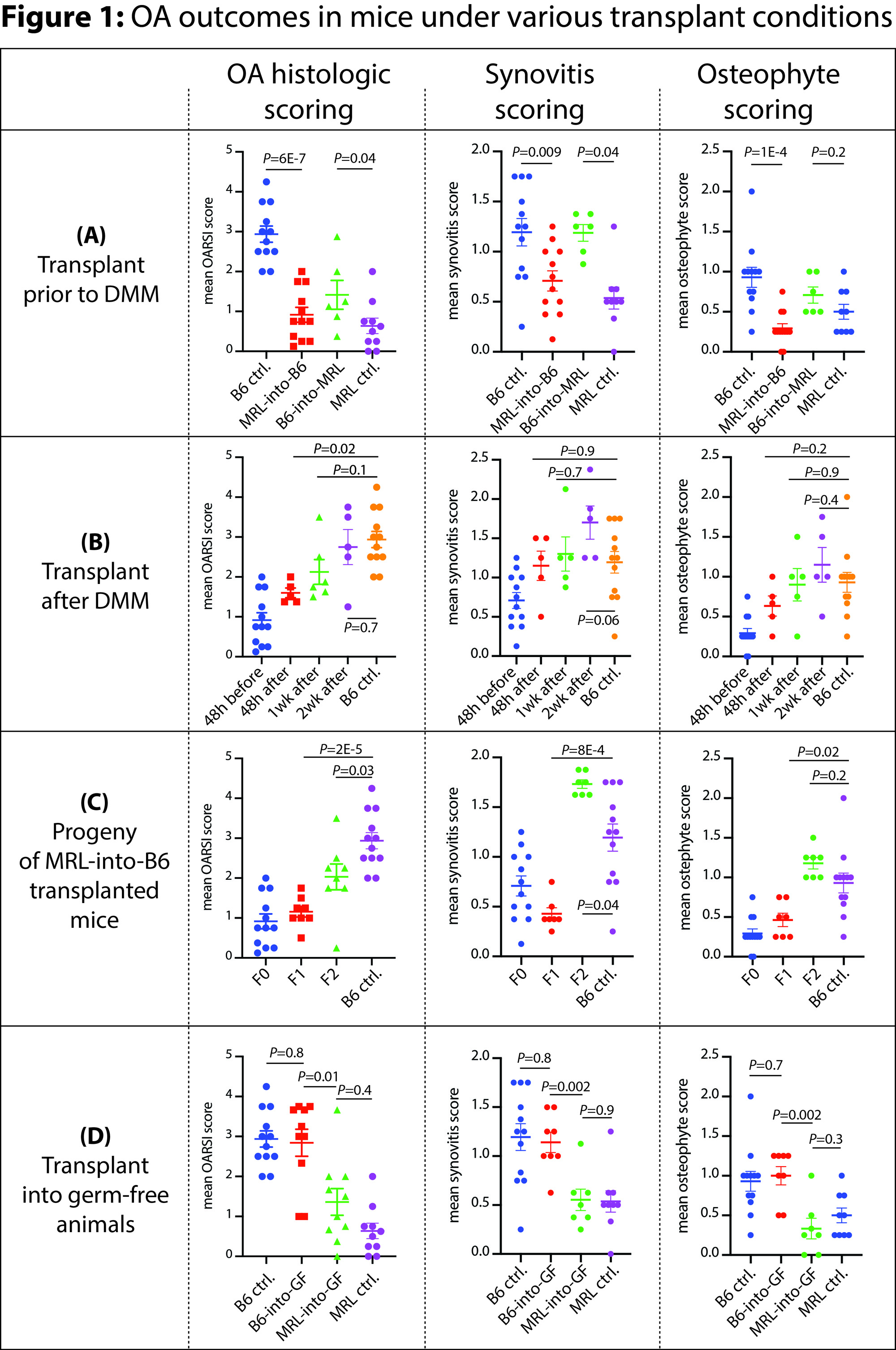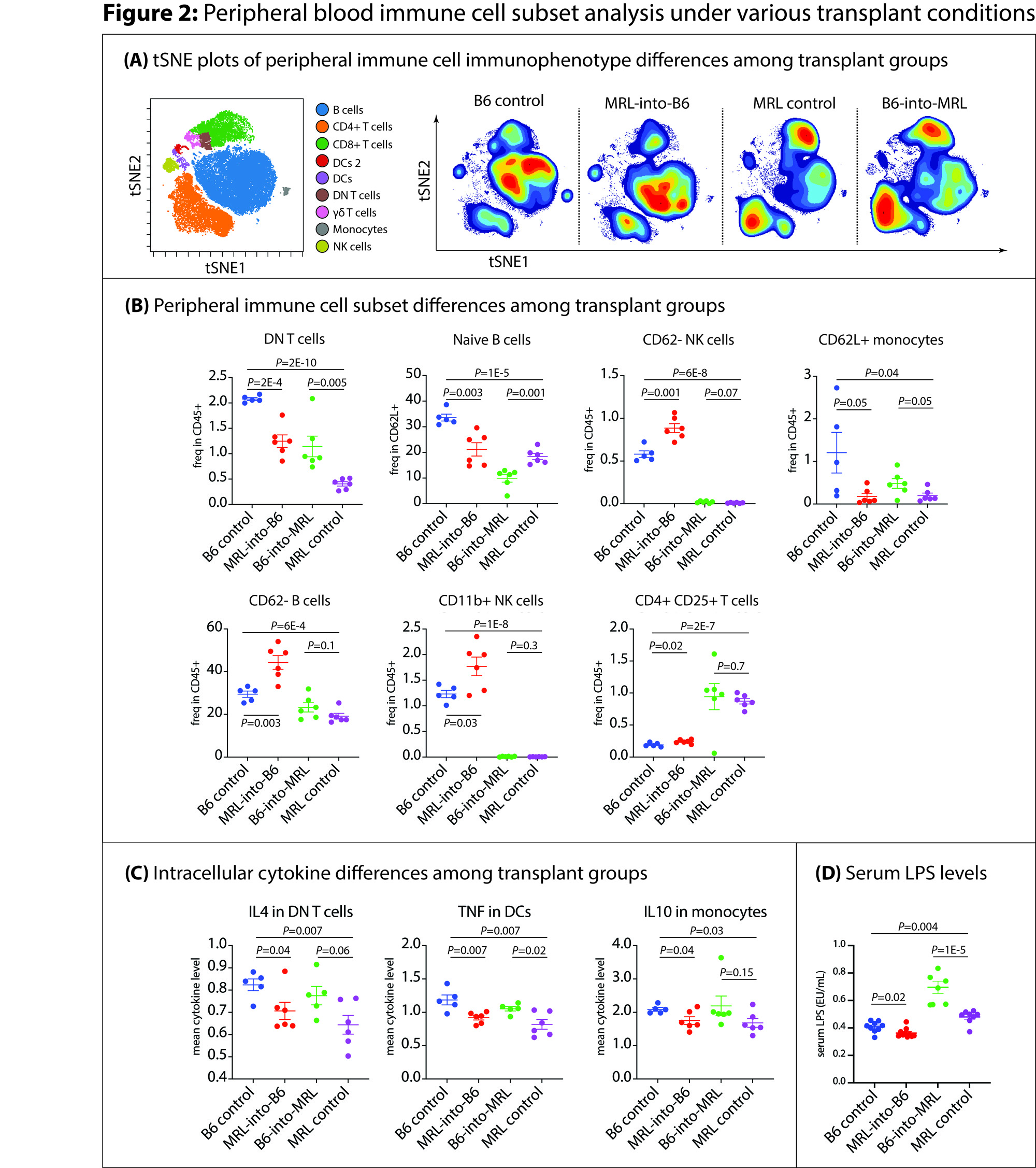Session Information
Date: Monday, November 13, 2023
Title: Plenary II
Session Type: Plenary Session
Session Time: 11:00AM-12:30PM
Background/Purpose: MRL/MpJ mice are protected from developing post-traumatic osteoarthritis (OA). We have previously shown transplantation prior to OA induction prevents OA development. We now extend this work to include measures of synovitis and osteophytes, transplantation after OA induction, transplantation breeding experiments, and peripheral blood immunoprofiling.
Methods: Adult male B6 and MRL mice were inoculated by oral gavage with diluted cecal contents from the opposite mouse strain or vehicle control. Adult male germ-free (GF) mice were inoculated with B6 or MRL cecal contents. A subset of male MRL-transplanted-B6 mice were bred to transplanted female mice and F1 and F2 generation mice were evaluated. Destabilization of the medial meniscus (DMM) surgery was then performed unilaterally to induce OA. Eight weeks after DMM, mice were sacrificed, knee joints fixed, paraffin-embedded, stained with Safranin-O and histologically graded for OARSI score, synovitis, and osteophytes. Immunophenotyping of splenocytes was performed by mass cytometry (CyTOF). Seurm LPS was determined by chromogenic assay.
Results: Adult male MRL and MRL-transplanted B6 (48h prior to DMM) were protected from OA (Figure 1,OARSI: P=6.7E-7, 6.3E-7 respectively, synovitis: P=0.002, P=0.009; osteophytes: P=0.02, P=0.0001). Transplant 48h after DMM (P=0.002) but 1 week (P=0.1) and 2 weeks (P=0.7) after DMM were not effective. Synovitis and osteophytes were not improved by transplant after DMM. B6-into-MRL transplant worsened OA (OARSI: P=0.04, synovitis: P=0.04). F1 and F2 progeny of MRL-into-B6 mice were protected from OA (OARSI: P=2E-5, P=0.003 respectively). B6-into-GF mice developed OA similar to B6 controls (OARSI: P=0.8), whereas MRL-into-GF mice were protected from OA similar to MRL controls (OARSI: P=0.4). Five cecal microbiome clades were strongly correlated with OA outcome (Lactobacillus R=-0.32, Akkermansia R=-0.31, Oscillospira R=-.28, Anaerostipes R=0.35, Christensenellaceae R=0.37, Rikenellaceae R=0.43). Immunophenotyping revealed reduced DN T-cells, reduced naïve B cells, reduced CD26+ monocytes, and increased CD4+CD25+ regulatory T cells with transplantation and in MRL mice vs. B6 controls. LPS levels were reduced in MRL-into-B6 vs. B6 controls.
Conclusion: Gut microbiome transplantation from OA-protected MRL mice to OA-susceptible B6 mice 48h before or 48h after DMM prevents OA development. Specific microbiome clades associated with OA protection, and are associated with changes in circulating immunophenotypes.
To cite this abstract in AMA style:
Dyson G, Barrett M, Khan M, Miranda C, Hanebutt N, Dunn C, Jeffries M. Microbiome Transplantation Prevents Osteoarthritis in Mice and Is Associated with Immunophenotype Changes [abstract]. Arthritis Rheumatol. 2023; 75 (suppl 9). https://acrabstracts.org/abstract/microbiome-transplantation-prevents-osteoarthritis-in-mice-and-is-associated-with-immunophenotype-changes/. Accessed .« Back to ACR Convergence 2023
ACR Meeting Abstracts - https://acrabstracts.org/abstract/microbiome-transplantation-prevents-osteoarthritis-in-mice-and-is-associated-with-immunophenotype-changes/


